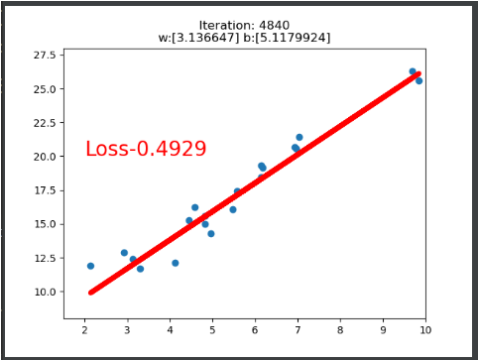01 | 什么是线性回归?
线性回归是分析一个变量与另外一个(或多个)变量之间关系的一种方法,该方法需要从实际数据中抽象出因变量Y、自变量X,且假定Y相对于X按照近似线性的方式变化,即函数图像上近似呈现一条直线。通常可以用下述公式表示,而模型求解目标为确定其中的斜率W与偏置b。

线性回归的求解过程一般分为三步:
-
确定模型,对于我们而言即确定模型求解目标是确定W与b
-
选择损失函数作为优化迭代目标,本例中选用常用的均方误差指标(MSE),即模型预测值与真实值差的平方和均值,用公式表示即:

-
最后就是求解MSE中相对于W与b的梯度并更新W与b,以获得较小MSE时的最优参数数值。

02 | PyCharm下的PyTorch代码
# 借助PyTorch实现一个简单的线性回归模型
import matplotlib.pyplot as plt
import torch
torch.manual_seed(10) #设定随机数种子
lr = 0.1 # 学习率
# 创建训练集
x = torch.rand(20, 1) * 10 # 创建一个(20,1)的Tensor,每个数值扩大10倍(默认小于1)
y = 2*x + (6 + torch.randn(20, 1)) # 近似线性公式,模拟随机噪声
# 构建线性回归参数张量
w = torch.randn((1), requires_grad=True)
b = torch.zeros((1), requires_grad=True)
for iteration in range(10000):
# 前向传播
wx = torch.mul(w, x)
y_pred = torch.add(wx, b)
# 计算MSE Loss
loss = (0.5 * (y - y_pred) ** 2).mean()
# 反向传播
loss.backward()
# 更新参数
b.data.sub_(lr * b.grad)
w.data.sub_(lr * w.grad)
# 绘图
if iteration % 20 == 0:
plt.scatter(x.data.numpy(), y.data.numpy())
plt.plot(x.data.numpy(), y_pred.data.numpy(), 'r-', lw=5)
plt.text(2, 20, 'Loss-%.4f' % loss.data.numpy(), fontdict={'size': 20, 'color': 'red'})
plt.xlim(1.5, 10)
plt.ylim(8, 28)
plt.title("Iteration: {}\nw:{} b:{}".format(iteration, w.data.numpy(), b.data.numpy()))
plt.pause(0.5)
if loss.data.numpy() < 1:
break
这里将目标参数看作是1维张量,从而具有了求解梯度相关的属性值,如果依次打印出迭代更新后的W与b,可以发现其逐步迭代变化:
0 : w: tensor([4.7343], requires_grad=True) b: tensor([0.4637], requires_grad=True)1 : w: tensor([1.1161], requires_grad=True) b: tensor([0.0062], requires_grad=True)
2 : w: tensor([3.8857], requires_grad=True) b: tensor([0.6501], requires_grad=True)
3 : w: tensor([3.3481], requires_grad=True) b: tensor([0.8179], requires_grad=True)
4 : w: tensor([1.2252], requires_grad=True) b: tensor([0.7864], requires_grad=True)
5 : w: tensor([4.6958], requires_grad=True) b: tensor([1.7186], requires_grad=True)
6 : w: tensor([1.5425], requires_grad=True) b: tensor([1.6252], requires_grad=True)
7 : w: tensor([2.4540], requires_grad=True) b: tensor([2.2383], requires_grad=True)
8 : w: tensor([4.0204], requires_grad=True) b: tensor([2.9985], requires_grad=True)
9 : w: tensor([0.5421], requires_grad=True) b: tensor([2.9742], requires_grad=True)
10 : w: tensor([3.7664], requires_grad=True) b: tensor([4.0679], requires_grad=True)
。。。 。。。
98 : w: tensor([0.4375], requires_grad=True) b: tensor([8.0425], requires_grad=True)
99 : w: tensor([1.6515], requires_grad=True) b: tensor([7.6664], requires_grad=True)
100 : w: tensor([3.2623], requires_grad=True) b: tensor([7.3332], requires_grad=True)
03 | 绘图展示
通过运行上述代码,可以实时每20次查看一次迭代情况,分别展示如下:可以看到经过100次迭代后,当MSE=0.897时,符合小于1条件,迭代终止,此时所得的直线已经近似于我们给定的线性模型。





 经过调整阈值为0.5,迭代1000次后可以得到更好的结果:
经过调整阈值为0.5,迭代1000次后可以得到更好的结果:
4840 : w: tensor([3.1366], requires_grad=True) b: tensor([5.1180], requires_grad=True)























 2099
2099











 被折叠的 条评论
为什么被折叠?
被折叠的 条评论
为什么被折叠?








